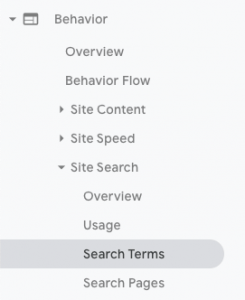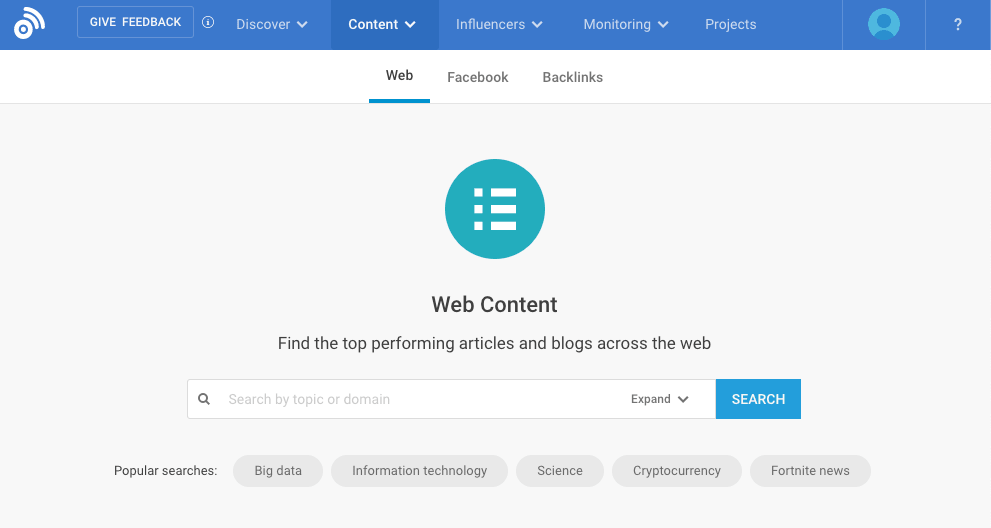
There are plenty of ways to come up with blog post ideas. But generating ideas people love is another story. So, whether you’re just starting a blog or struggling to come up with fresh topics for an existing one, you’ve come to the right place. Because we’re going to explore seven strategies for coming up with blog topic ideas that will keep your editorial calendar full and your audience coming back for more.
Each strategy includes a set of suggested tactics. Since there are a lot of them, use the navigation menu below to jump to a section that sounds interesting. Then bookmark this page and come back when you are ready to try something else.
7 Strategies for Coming Up with Blog Post Ideas
- Answer Real Customer Questions
- Identify Topics People Actually Search
- Spy on Your Competition
- Analyze Shareworthy Content
- Learn from the Experts
- Create Original Research
- Embrace Thought Leadership
Strategy 1: Answer Real Customer Questions

Sometimes a customer will land on your website knowing exactly what they want. More often, however, they find you as part of a research and decision-making process we call the buyer’s journey. This matters a lot when you’re trying to come up with blog post ideas because customer questions (and the way they phrase them) change depending on who they are and where they’re at in their journey.
Take this blog post, for example. If I wanted to attract content marketing professionals at large companies who are early in their buyer’s journey, I may have chosen a different title. Perhaps something like “7 Content Ideation Strategies to Fuel Your Next Brainstorming Session.”
But that’s not the case. My target customers are small or mid-sized businesses that don’t have a content marketing strategist on staff and need help building and executing goal-oriented content strategies. They’re unlikely to use phrases like “content ideation.”
So, put yourself in your customer’s shoes and create a list of questions they might ask (in their words) at each step of their journey. When you run out of ideas, here’s how you can expand your list.
Ask your audience what they would like to hear from you.
It never hurts to pose the question directly to the people who matter most. Think about the many ways your business interacts with its customers. Is there a way to ask this question during those interactions? Here are a few possibilities:
Create an exit survey.
Set it to trigger when people leave your website. Ask what question or concern brought them to your site. If you don’t want to ask every visitor, set some parameters. Maybe you can limit it to people who visit at least two pages before leaving, for example.
Ask the question in your newsletter.
Make it compelling by offering an incentive to anyone who submits an idea you use. Just be sure the incentive is meaningful to your customers, like a gift card, discount, or even an honorable mention (and link) on your blog.
Interview your customers.
You don’t have to ask them specifically for blog post ideas if that seems awkward. Instead, ask what led them to engage with your business. Ask what they’re working on or what their biggest challenges are. Then let them talk while you listen and jot down ideas.
Read customer blog comments.
If you have a comment section on your blog encourage your readers to engage. You can do this by asking a question at the end of your post, like “What would you add?” or “Is there anything else about this topic that you would like to know?” Then, make sure you respond to any comments before mining them for ideas.
Examine internal site search data.

You can get your internal site search data through Google Analytics, but Google doesn’t collect the information automatically. You need to configure the site search setting for each view where you want to see the data. Once the information is available, you can find the reports under Behavior > Site Search.
Buddy up with your sales team.
Your sales team is on the front lines every day, fielding questions from customers. And these aren’t just any questions. They’re the money questions – the ones people ask while trying to make a purchasing decision. In other words, these are the questions you need to answer to convert website visitors into paying customers.
Most sales professionals would happily share this information. They may even invite you to join the next time they are meeting a prospect so that you can hear the questions firsthand. Especially if doing so will lead to an arsenal of content that will help them close deals.
Talk to your colleagues in customer service.
Similar to your sales team, customer service has a direct line to your customers. But, in this case, they hear questions from people who have already tried your products. These questions are gold. Providing answers will help you retain customers and improve your bottom line.
Strategy 2: Identify Blog Post Topics People Actually Search

There’s no point in writing a great blog post if no one will ever see it. So another way to come up with blog post ideas is to tap into the search engines themselves.
Information about the keywords people enter into the search engines is available to anyone. You can explore this data to learn which phrases people search the most and how difficult it will be to rank. You can then combine what you learn with the customer questions above to refine your topics and optimize them for search.
Here are a few ways to go about this.
Use keyword research tools.
There are some great tools out there, and if you do this kind of work a lot, they’re worth every penny. A couple that I have tried (and enjoyed) are Ahrefs and SEMRush, but there are plenty of others to choose from.
Most tools will allow you to do a few searches or set up a trial for free, so take your time until you find one that’s right for you. When it comes to conducting keyword and competitive research, they’re pretty similar. But their features branch out from there, each one offering something a little different.
Extract keyword data from Google Ads.
If you have a Google Ads account, you can get keyword search volume using the keyword planner tool. While this is certainly useful information, it’s important to remember that this tool is for advertisers. The competitiveness information refers to how easy it is to compete with other advertisers who are bidding on each keyword. There is no information on how competitive it is to rank in organic search.
Mine your own keyword data in Google Search Console.
Another way to get topic ideas is to dig into your own data in Google Search Console. When you create a new page for your website it will often rank for many terms, not just the one you’re targeting. Examining this information can help you come up with blog post ideas or angles you haven’t thought of yet.
Experiment with Google Autosuggest.

Be careful, though, this can be addicting.
You can also look at the “People also ask” box that often appears in the search results. Or, scroll down to the bottom of the page to see a list of related searches.
Use question-generating tools.
Question-generating tools, like Answer the Public and Ubersuggest, provide much of the same information you would find in Google’s Auto Suggest and Keyword Planner. But you can gather more information quickly. And, better yet, they’re free.
Answer the Public takes whatever keyword you enter and turns it into a list of questions. Many of which could easily become blog post ideas. Ubersuggest provides an expanded list of keywords and questions. It also tells you how hard it will be to rank for those terms in organic search.
Strategy 3: Spy on Your Competition

Your competitors can be a terrific resource when you’re trying to find topics for blog posts. I’m not saying you should copy them, of course. But you can read your competitors’ blog posts in search of inspiration.
Study their blog categories and read their articles to gain insight into their strategy. What types of blog posts do they write? What topics do they prioritize? How are they positioning themselves? And how do their readers respond? This information will spark ideas and will help you create something different so you can stand out.
If this sounds like a lot of work, consider taking advantage of these shortcuts:
Subscribe to your competitor’s blogs.
Sign up for your competitor’s mailing list to get their blog posts delivered straight to your email inbox. If you don’t feel comfortable subscribing with your company email, use a personal one instead.
Set up Google Alerts.
You can get a notification every time your competitor turns up in a Google search by setting up a Google alert. Not only will this help you to see their posts, but it will keep you abreast of their news and provide insight into their broader strategy.
Perhaps you’ll learn about new websites where you can republish content. Or, maybe you’ll discover that they’re writing guest posts or engaging in co-marketing activities. Whatever you learn, use this insight to improve your game.
Use a tool to identify top-performing competitive content.
If you have access to a content analysis tool, like BuzzSumo, you can dig into competitive content even more.
For instance, in BuzzSumo, you can enter a competitor’s URL to get a list of their most successful content based on how it performed on social media. You can then sort that content by the number of shares per platform or the links each piece has earned.

You can also run that same website through their backlink analysis tool. This will return a list of articles that reference your competitor, sorted by their social performance.
Strategy 4: Analyze Shareworthy Content
When you create a new piece of content, you want people to find and share it. So, pay attention to the types of posts that generate buzz.
For instance, the format of your blog post can have a big impact on its success. According to a study of 912 million blog posts conducted by Brian Dean of Backlinko and BuzzSumo, “list posts generate 203% more shares than infographics and 218% more shares than how-to articles.”

But it also helps if you choose popular topics to write about. You can tune in to what people are saying and sharing on social media to get a ton of blog post ideas. Here’s how:
Utilize social media listening.
Jump into your favorite social platforms and listen to the chatter in your industry. Notice the questions people ask about topics that interest you or the concerns they air about your competitors. You can also search hashtags, listen in on TweetChats or Facebook Group conversations, or just flip through your main feed.
You don’t have to spend a lot of time on this, just 10 minutes a few times a week or so to see what catches your eye.
Read question-and-answer forums.
Similar to social media, question-and-answer forms are a good source of inspiration. Platforms like Quora or NextDoor have broad appeal, of course. But you can also dig into forums that serve specific industries, crafts, or products.
Explore trending topics tools.
There are a number of tools that make gathering insight into trending topics easier. Many social media management tools offer a listening feature. While tools like BuzzSumo allow you to gather data from social, search, and question/answer forums all in one place. If you wish to use these tools a lot, however, you’ll need a subscription.
A free tool that is often overlooked is Google Trends. Click on the hamburger menu in the top left corner to get a list of trending searches. Or, enter a specific topic into the search bar to get information on the volume and location of searches as well as related queries.
Strategy 5: Learn from the Experts

Every field has respected leaders or experts who follow trends in the industry and share their knowledge. These pros have already mastered the art of producing content their audience loves. Why not find inspiration in their work?
You may already subscribe to their newsletters or blogs. Or, maybe you follow them on social networks. But here are some other ways to gather ideas.
Take a look at relevant books on Amazon.
Find and explore books about your topic of interest, paying particular attention to the table of contents and the reviews. Is there a concept you could cover on your blog but from a different perspective? If one chapter, in particular, resonates for you, perhaps you break it down into subtopics and give it your own spin in a series of posts.
Peruse conference sessions.
Take a look at conferences in your space and the topics speakers will address. Not only will this expose you to a few experts you haven’t heard of already, but you might find an idea that you can expand upon.
Tune in to podcasts.
Listening to podcasts from experts in your space can certainly be inspiring, but don’t stop there. Tune in to podcasts from other fields or just for fun. I don’t listen to a lot of podcasts, but when I do, I favor stories from entrepreneurs or Ted Talks. In addition to being enjoyable, they sometimes spark fresh ideas that I can apply to my work.
Explore YouTube.
If you really love blogging, you may not wish to produce videos. But there’s no reason why you can’t consume it. Browse through the offerings related to your topic. Watch anything interesting and pay attention to the questions and comments to find concepts you can expand upon.
Similar to the “spy on your competition” strategy, the intent here isn’t to create copycat content. Instead, look for inspiration so you can explore similar or complementary blog post ideas and add your perspective. Or, keep an eye out for subjects that aren’t covered very well and a chance to create something that will stand out, like an ultimate guide.
Strategy 6: Create Original Research

If you have the resources, conducting your own original research is a wonderful way to create something unique and attract a ton of links.
You could do something simple, like run a few polls on Twitter and share the responses in a creative blog post. Or, you could go all out and gather enough material for one substantial report and a whole series of related posts that dive deep into certain findings.
For example:
Analyze and report on your own data.
Do you have a product or service that results in useful data about trends in your space? Can you share that insight without compromising anyone’s privacy? If so, consider publishing those findings in a report and extracting key points to share on social media or to reference in other blog posts.
Or, look for customers who are doing groundbreaking work with the help of your product or service. Ask them if they’d be willing to share their experience with others, then write an amazing case study that makes both of your companies look good.
Create a survey and record your findings.
People love survey data they can relate to. Especially when it provides insight into the experiences of your peers and makes you feel less alone. So, if your business serves a very specific niche, like pharmaceutical salespeople or even cat lovers, you have an opportunity.
Create a survey to gain insight into typical practices or concerns among your target audience. Invite current and potential customers to participate so you can get a sizeable sample, then publish your findings. This is a great way to delight your customers and attract links. And the surveying process itself gives you a non-salesy excuse to reach out to your target audience.
Conduct an experiment and publish the results.
Do you have questions about certain aspects of your work or industry? Questions your target audience would find interesting too? What if you conducted an experiment to test your theories? Not only would you get some of those questions answered, but you can share the results and boost your reputation as an expert.
Strategy 7: Embrace Thought Leadership

Becoming a “thought leader” in your space sounds amazing, doesn’t it? But it’s an elusive goal that will never happen unless you clarify what “thought leader” means to you and put in the work to make it happen.
If you’re comfortable with public speaking, volunteering to present at industry events is an obvious way to create a name for yourself. But if you’d rather stick to blogging, you’ll need to get creative when looking for blog post ideas. Here are a few possibilities:
Report on developments in your industry.
Follow the happenings in your space, report them to your readers, and add your unique perspective. Provide some background on what led up to the events. Or share your thoughts on why they unfolded the way they did and what you believe will happen next.
Become a resource for relevant statistics.
If original research isn’t an option for you, compile a go-to resource instead. When others share data or report on statistics for your industry, capture that information in a file. Then create a super organized blog post or resource where you can present them all in one place. Just don’t forget to keep it up to date as new information comes to light.
Nurture industry relationships with a roundup post.
Flattery is one of the best ways to get on the radar of important people in your industry. Consider choosing a topic that’s important to your industry and asking experts to share their thoughts. Then, publish their opinions along with your own.
This gives you a good reason to reach out and introduce yourself to others in your space. And the post itself will probably do quite well because each one of those people is likely to share it.
How to Find Blog Post Ideas: The Bottom Line
By this time, I hope you’ve compiled a list of ideas you’d like to try. And, perhaps, you’ve realized it’s not hard to come up with blog post ideas that people love at all. What’s hard is deciding which strategy to try first.
Take an honest look at the state of your business, your goals, and your available resources. Then focus on the most impactful ideas that fit within your constraints. Now you’re ready to get to work creating the kind of blogs that will get your audience begging for more.
Do you have ideas that should be on this list? Feel free to share them in the comments below.


